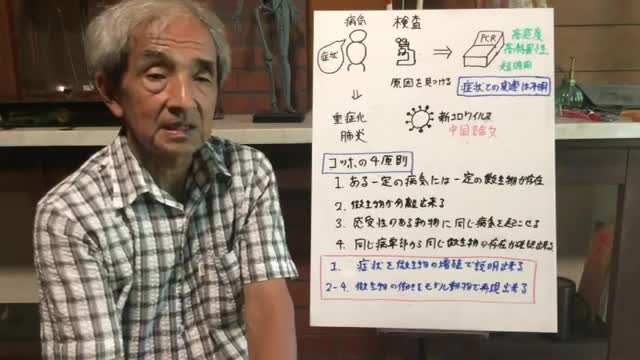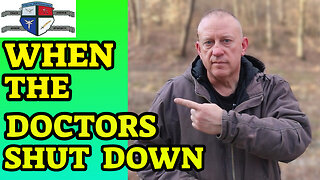Premium Only Content

【101】コッホの4原則を考え直す - 大橋眞
今回の騒動は、感染症という近代医学の祖とも言うべき疾患の基本が問われています。科学を取り入れた近代医学のレベルが問われているということと大差がないかもしれません。一体感染症とは何なのか、病原体とは何なのかということを科学的に明らかにしたのは、ドイツのロベルト・コッホです。彼が感染症の病原体同定の基本的な考え方として、コッホの4原則という法則を残しています。これについて、科学とは何かという考え方に当てはめて考えてみます。コッホの4原則の中で、1番目の項目は、自然観察に相当しますl。2-4番目は、実験に相当します。自然観察により仮説を立てて、これが病原体候補であるという仮説を、実証実験により確かめるわけです。コッホの4原則を満たすことを確認することによって、科学とは何かというサイクルが完結するわけです。このように、コッホの4原則は、感染症の考え方に科学の視点を取り入れて、その具体的な手順を示したものと言えるわけです。
コッホの4原則の第一項である「一定の患者に一定の微生物が存在する」というのはウイルスの増殖と関係して症状が現れるということに相当します。これは、自然観察です。2-4番目は、ウイルスを用いた感染実験です。病原体がこのウイルスであるという仮説のもとに、実際に実験によって確かめるわけです。今回の感染症に関しては、コッホの4原則の第一項「一定の患者に一定の微生物が存在する」すなわち、ウイルスの増殖と関係して症状が現れるという事象も、明らかな形で証明した論文が見当たりません。2-4番目に関しては、動物実験で同じウイルスが動物から確認できたというものが見当たりません。このように今回の騒動で問題となっているウイルスは、コッホ原則の4つがすべてを満たすというレベルでなく、第一項ですら満足に満たす科学論文が存在しないのです。
このようなことから、少なくとも現時点では、このウイルスが病原体になるということが明らかにされていないと考えられるのです。無症状者が感染源になるという論文の問題点が、このことからも指摘できるわけです。科学とは何かというスタートラインである自然観察が、症状の発現と病原体の増殖が関連するということに注目するべきです。これが明らかにされない以上、無症状者が感染源になるという話は成立しないのです。
This uproar is questioning the basics of infectious diseases, a disease that can be said to be the ancestor of modern medicine. It may not be much different from the question of the level of modern medicine that incorporates science. It was Robert Koch of Germany who scientifically clarified what an infectious disease is and what a pathogen is. He retains Koch's four principles as a basic idea for identifying pathogens of infectious diseases. Let's think about this by applying it to the idea of what science is. Of the four principles of Koch, the first item corresponds to nature observation. The second to fourth correspond to experiments. A hypothesis is made by observing nature, and the hypothesis that this is a pathogen candidate is confirmed by empirical experiments. By confirming that the four principles of Koch are met, the cycle of what science is is completed. In this way, Koch's four principles can be said to show the concrete procedure by incorporating a scientific perspective into the idea of infectious diseases.
The first item of Koch's four principles, "a certain microorganism exists in a certain patient", corresponds to the appearance of symptoms related to the growth of the virus. This is a nature observation. The second and fourth are infection experiments using viruses. Based on the hypothesis that the pathogen is this virus, it is actually confirmed by experiments. Regarding this infectious disease, the first paragraph of Koch's four principles, "a certain microorganism exists in a certain patient", that is, a paper that clearly proves the phenomenon that symptoms appear in relation to the growth of the virus. I can't find it. Regarding the 2nd-4th, I can't find any animal experiments that confirmed the same virus. In this way, the virus at issue in this uproar is not at the level where all four of the Koch's principles are satisfied, and there is no scientific paper that satisfies even the first term.
From this, it is considered that it has not been clarified that this virus becomes a pathogen, at least at this time. This also points out the problem of the paper that asymptomatic people are the source of infection. It should be noted that nature observation, which is the starting line of what science is, is associated with the development of symptoms and the growth of pathogens. Unless this is revealed, the story that asymptomatic people are the source of infection cannot be established.
-
 22:10
22:10
CatfishedOnline
11 hours agoVictim Sells Her Home To Help A Romance Scammer!
21.4K9 -
 6:51
6:51
Film Threat
20 hours agoBOB TREVINO LIKES IT | Film Threat Reviews
19.8K4 -
 1:59:05
1:59:05
TheDozenPodcast
19 hours agoFalse ALLEGATIONS, supporting Tommy Robinson & Police HARASSMENT: Laurence Fox
29K8 -
 21:15
21:15
Mrgunsngear
19 hours ago $2.60 earnedNavy Sailor Wrongfully Jailed For Guns He Didn't Have - Update Under Trump's DOJ
26K25 -
 8:50
8:50
Ethical Preparedness
1 day agoQuickly Crush & Reverse Type 2 Diabetes after the Collapse
24.5K5 -
 15:06
15:06
Russell Brand
1 day agoPeople Are SHOCKED As Bill Burr Goes After Elon Musk on 'The View'
145K250 -
 7:32:11
7:32:11
SpartakusLIVE
14 hours ago#1 Action HERO ends your weekend in a FIERY BLAZE of non-stop GLORY
122K5 -
 2:34:20
2:34:20
vivafrei
22 hours agoEp. 257: More ROGUE Judges! More Deportations! Candace v. RFK Jr.? Wisconsin Election & MORE!
214K497 -
 2:27:35
2:27:35
Nerdrotic
15 hours ago $26.17 earnedGobekli Tepe Coverup, Pyramid Structures w/ Jimmy Corsetti & Wandering Wolf | Forbidden Frontier 096
89.4K38 -
 54:17
54:17
Man in America
20 hours ago50 MILLION Illegals: The TIME BOMB Threatening to Destroy America w/ J.J. Carrell
72.4K97